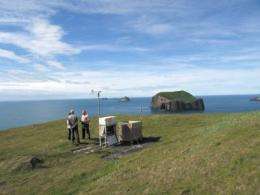New study links dust to increased glacier melting, ocean productivity

A University of Miami (UM) Rosenstiel School of Marine and Atmospheric Science-led study shows a link between large dust storms on Iceland and glacial melting. The dust is both accelerating glacial melting and contributing important nutrients to the surrounding North Atlantic Ocean. The results provide new insights on the role of dust in climate change and high-latitude ocean ecosystems.
UM Rosenstiel School Professor Joseph M. Prospero and colleagues Joanna E. Bullard and Richard Hodgkins (Loughborough University, U.K.) analyzed six years of dust concentrations collected at the Stórhöfi research station on the island of Heimaey, which is located 17 km (10.5 mi) off the south coast of Iceland. The results show large increases in dust concentration, which can be traced to dust sources adjacent to major glaciers on Iceland.
As the glaciers melt, rivers of black, volcanic-rich sediments flow into the surrounding land and nearby ocean. Intense windstorms, common in the high-latitudes, eventually sweep up the dried sediments. The resulting dust storms are clearly visible in satellite images that show huge dust plumes extending hundreds of kilometers south over the Atlantic Ocean. Iceland glaciers are melting at a high rate due to global warming and to sub-glacial volcanic activity.
"The dust in Iceland dust storms can also have an impact on the glaciers themselves," said Prospero, UM Rosenstiel professor emeritus and lead author on the study. "The black dust deposited on the glacier surface absorbs solar radiation thereby increasing the rates of glacial melting."
Iceland dust can also affect ocean processes over the North Atlantic. The researchers suggest that the iron-rich dust provides a late summer/early fall nutrient boost to the typically iron-depleted North Atlantic Ocean waters. The iron increases the ocean's primary productivity and stimulates the growth of marine biota. This, in turn, increases the draw down of CO2 from the atmosphere to the ocean.
Currently there is much research on global atmospheric dust processes but most of this research focuses on tropical and arid regions in Africa and the Middle East, the most active dust sources. This study is one of the few to look at high-latitude areas, and is the first to review measurements over such a long time period (February 1997 to December 2002).
The study shows that the dust transport in cold, high-latitude regions, such as Iceland, are comparable to concentrations seen at low latitude regions near the equator, in particular, the well known Saharan dust transport across the mid Atlantic, from the west coast of Africa to the Caribbean and South Florida.
Due to increased air temperatures linked to global climate change, glaciers worldwide are rapidly retreating. The melting of glaciers, including those on Iceland, would also contribute to sea level rise.
"The dust processes taking place on Iceland are likely to be occurring in other high latitude glacierized regions," said Prospero. "Similar glacier-related dust storms have been seen in Alaska and in Patagonia. On the basis of this research we might expect that cold climate dust activity will become more widespread and intense as the planet warms."
More information: The study, titled "High-Latitude Dust Over the North Atlantic: Inputs from Icelandic Proglacial Dust Storms," was published in the March 2 issue of the journal Science.
Journal information: Science
Provided by University of Miami















